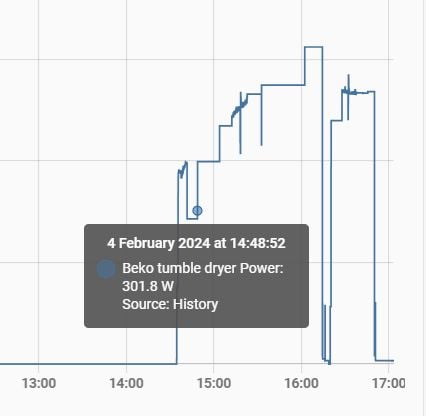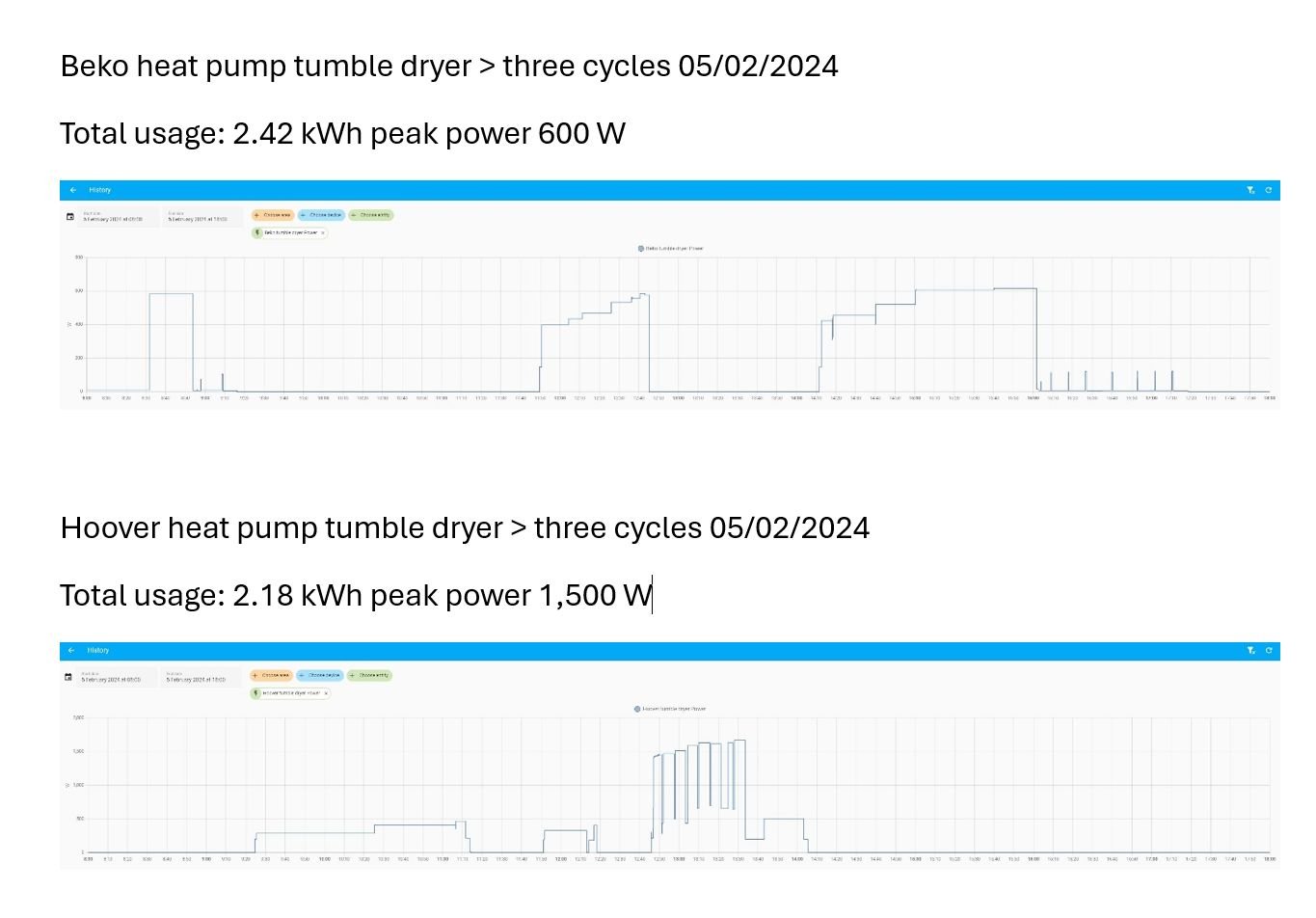We’d like to remind Forumites to please avoid political debate on the Forum.
This is to keep it a safe and useful space for MoneySaving discussions. Threads that are – or become – political in nature may be removed in line with the Forum’s rules. Thank you for your understanding.
📨 Have you signed up to the Forum's new Email Digest yet? Get a selection of trending threads sent straight to your inbox daily, weekly or monthly!
Has MSE helped you to save or reclaim money this year? Share your 2025 MoneySaving success stories!
Heat pump tumbe dryers: no measurable saving over condenser or vented
Comments
-
Nope.Got a Sharp heat pump tumble dryer in the garage. Fill it up, whack it on for 2 hours and everything comes out perfect.1
-
Ok. So we have just dried a couple of large towels, a light load. The power measurement below peaks at 623 watts. The energy used is 1.11 kWh and the time taken is 144 minutes. Does this seem right for a heat pump dryer?

I have osteoarthritis in my hands so I speak my messages into a microphone using Dragon. Some people make "typos" but I often make "speakos".0 -
We have gone from condenser to heat pump to condenser over the years and there's no noticeable change in our electricity consumption, certainly not enough to cover the cost of scrapping the heat pump after 4 years of use.1
-
Ours, depending on programme, has a range of dryness levels you can select from with "normal" being the default but also customisable. Going for "extra dry" they come out perfectly dry without that scorched feeling of an old-fashioned machine.
Similarly it monitors the humidity and so whilst a programme may start saying its going to take 2.5 hours if there are less items in the drum etc it quickly drops down the timescale.
Never measured against our old washer-dryer but would be highly surprised if it wasn't vastly more efficient given the old machine had a 4kg drying capacity which meant typically the dryer was going for 5-6 hours for each 8kg washing load and still came out damp. With the new standalone washer and tumble dryer the clothes come out the washer dryer with its 1600 spin (v 1400) and the drying of the full load is done in 2-2.5 hours. The machine reports about 0.6KW use but don't have a use measurement for the old one.0 -
I can second a previous poster's observation that there does seem to be a huge variation between both the efficiency and effectiveness of heat pump dryers from different manufacturers.
We have a cold single-glazed conservatory in which we have a Bosch heat pump dryer. Not sure exactly how old it is as it was second hand when I bought it in late 2020. It has worked reliably for us even on the coldest winter mornings, typically taking about 90-120 minutes to dry a full load on the 'cottons - cupboard dry' setting, consuming 0.8-1.2 kWh. The clothes are pleasantly warm and all but thick jackets fully dried at the tend of the cycle.
When my parents ancient condenser dryer, which is located in their equally cold garage died this winter I recommended they buy a heat pump one. They bought a brand new Hotpoint branded one (can't remember the model) and they find it takes 3.5-4 hours on a cold winter day and then sometimes the clothes are still slightly damp.
1 -
Our condenser dryer uses around 4kWh for a two hour cycle.DullGreyGuy said:.. drying of the full load is done in 2-2.5 hours. The machine reports about 0.6KW use but don't have a use measurement for the old one.0 -
As well as the different ratings, some also have variable cycles depending on load and humidity. For example, I put a half load (mix of clothing and towels) on our condensing dryer overnight last night and it ran for a little over 1 hour until complete, consuming 1.9kWh. I It's a Hotpoint B rated machine, but at least 10 years old.Qyburn said:
Our condenser dryer uses around 4kWh for a two hour cycle.DullGreyGuy said:.. drying of the full load is done in 2-2.5 hours. The machine reports about 0.6KW use but don't have a use measurement for the old one.0 -
Thank you all for the postings here and for helping us to rethink.
This is a limited sample test drawing data from just one day. We ran two heat pump tumble dryers over three cycles each using various programmes and differing loads. Energy measurements were obtained using Antela smart plugs.
In these samples, the average energy usage per cycle appears to be 0.77 kWh.
The longest cycle consumed approximately 1 kWh of energy.
The ebac hot fill washing machine used 0.58 kWh in the day. The estimated cold fill energy usage would be about 3 kWh. The tumble dryer to washing machine energy ratio is 4.6/3 = 1.5:1. That looks better than the 2:1 we had with the condenser and vented dryers.
Family observation: The drying of towels and bedding is satisfactory, but clothing remains damp around areas with thick materials such as collars and cuffs. The machines seem to sense that the clothing is dry when there are still wet areas. The Hoover can be set for an extra drying period, whereas the Beko is guided purely by its sensors.
I have osteoarthritis in my hands so I speak my messages into a microphone using Dragon. Some people make "typos" but I often make "speakos".1 -
So in summary as suggested if you are using the same 1000kwh they are simply being used more given your ratios.Sterlingtimes said:Thank you all for the postings here and for helping us to rethink.
This is a limited sample test drawing data from just one day. We ran two heat pump tumble dryers over three cycles each using various programmes and differing loads. Energy measurements were obtained using Antela smart plugs.
In these samples, the average energy usage per cycle appears to be 0.77 kWh.
The longest cycle consumed approximately 1 kWh of energy.
The ebac hot fill washing machine used 0.58 kWh in the day. The estimated cold fill energy usage would be about 3 kWh. The tumble dryer to washing machine energy ratio is 4.6/3 = 1.5:1. That looks better than the 2:1 we had with the condenser and vented dryers.
Family observation: The drying of towels and bedding is satisfactory, but clothing remains damp around areas with thick materials such as collars and cuffs. The machines seem to sense that the clothing is dry when there are still wet areas. The Hoover can be set for an extra drying period, whereas the Beko is guided purely by its sensors.
More loads being dried.1 -
Thank you, Bella; your conclusion is correct.BellaBlondykeTheThird said:So in summary as suggested if you are using the same 1000kwh they are simply being used more given your ratios.
More loads being dried.
But herein resides the problem and the reason for the diseconomy of our two heat pump tumble dryers.
Using my detailed data across 36 days, it would appear that we are averaging, on this limited sample, 2.7 kWh a day or 982 kWh a year. There is no saving over our prior use of vented or condenser dryers.
My family members (wife, father-in-law and son) agree that the drying of bedding and towels is effective.
However, the dryers both fail to dry clothing satisfactorily. The thin material dries but folded material such as cuffs, pockets and collars remain damp.
We could hang up the clothing to air it, but this defeats the purpose of using a dryer in the first place. We have tried putting the clothing away with damp areas, but this leads to the clothing smelling musty.
With Beko dyer, it is difficult to override the sensor and extend the drying cycle. I would view this as a design defect. The Hoover will accept a second drying cycle.
Therefore, the reason for the extra loads is because the drying is poor in the first place. The need for extra drying negates the reason for having a heat pump dryer in the first place. Next time, we will buy a condenser dryer.
I have osteoarthritis in my hands so I speak my messages into a microphone using Dragon. Some people make "typos" but I often make "speakos".0
Confirm your email address to Create Threads and Reply

Categories
- All Categories
- 352.9K Banking & Borrowing
- 253.9K Reduce Debt & Boost Income
- 454.7K Spending & Discounts
- 246K Work, Benefits & Business
- 602.1K Mortgages, Homes & Bills
- 177.8K Life & Family
- 259.9K Travel & Transport
- 1.5M Hobbies & Leisure
- 16K Discuss & Feedback
- 37.7K Read-Only Boards



